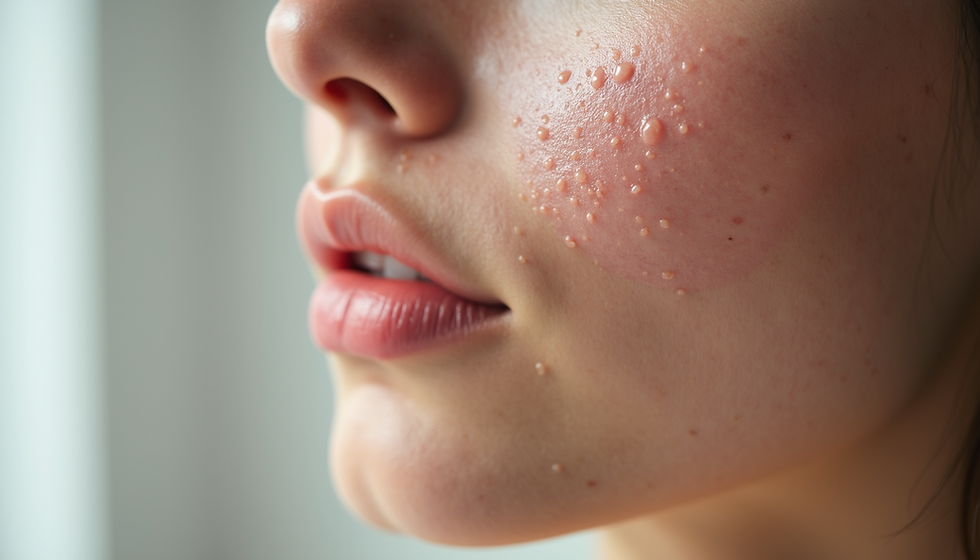What Are My Options for Scars? Treatment and Prevention
- Bianca Cypser
- Dec 10, 2023
- 3 min read
When a wound heals, it may eventually turn into a scar, which can be quite distressing, especially if it's on your face. Facial scars come in various forms and can result from different causes. Since your face is exposed to the environment throughout the day, scars on this area may require special attention and care during the healing process. Fortunately, there are numerous treatment options available to address facial scars effectively. In this article, we'll explore these options to help you make an informed decision with the guidance of a dermatologist or esthetician.
1. Dermabrasion:
Dermabrasion is a highly effective method for treating facial scars. Unlike over-the-counter microdermabrasion kits, professional dermabrasion is performed by a dermatologist using a specialized wire brush or wheel to exfoliate the top layer of skin on your face. This process helps in smoothing out the skin's surface.
Possible complications of dermabrasion include infection, darkening of the skin, redness, swelling, and uneven skin tone. While these complications are rare, it's essential to discuss them with your dermatologist.
2. Microneedling:
Microneedling is another beneficial option for addressing facial scars. It stimulates the production of new collagen in the skin, which can help smooth out the surface and improve the appearance of scars. Skilled practitioners, like those at Imagine You New in St. Petersburg, Florida, offer microneedling treatments.
3. Chemical Peels:
Chemical peels involve the application of mild acids to exfoliate the top layer of skin, revealing a fresher layer beneath. There are three types of chemical peels: deep, superficial, and medium. Deep peels, using phenol, are commonly used for treating scars, while superficial and medium peels are suitable for discoloration and minor scars.
4. Laser Resurfacing:
Laser resurfacing is a procedure that also removes the top layer of skin to improve scar appearance. It uses high-powered laser beams for this purpose, with two types available: erbium and carbon dioxide. Carbon dioxide laser resurfacing is highly effective in scar treatment, but you'll need to keep the treated area bandaged until it fully heals.
5. Plastic Surgery:
For more severe scars, plastic surgery may be an option. A plastic surgeon can surgically remove or alter scar tissue using a scalpel. Depending on your goals and the scar's severity, the surgeon may remove the scar, the epidermis, or reposition the scar to minimize its appearance.
Minimizing and Preventing Scars:
Taking proactive steps to treat wounds can help minimize or prevent scars from forming. Keep the wound clean, apply petroleum jelly or Vaseline to keep it moist, and avoid scab formation. Scar camouflage tattooing is an excellent option for healed scars, as it blends them seamlessly with your skin tone. This technique should be done by a profession and experienced paramedical tattoo artist who understands how to make the scar look like skin. The tattoo ink should never be shown and should look like skin. At imagine you new in St. Petersburg Florida, Bianca specializes in this check this out at

Remember to wear sunscreen daily, with SPF 30 or higher, to prevent scars from darkening or becoming more noticeable due to sun exposure.
In conclusion, numerous treatments are available for facial scars, and the choice depends on your budget, risks, and the type of scar you have. While most scars are permanent, these treatments can significantly reduce their appearance. Collaborate closely with your dermatologist to determine the best option for your specific needs. If you notice any unusual changes in your scar, such as itching, redness, or growth, consult your doctor promptly.






(1)_edited.png)



AV在线看 AV在线看;
自拍流出 自拍流出;
国产视频 国产视频;
日本无码 日本无码;
动漫肉番 动漫肉番;
吃瓜专区 吃瓜专区;
SM调教 SM调教;
ASMR ASMR;
国产探花 国产探花;
强奸乱伦 强奸乱伦;
google seo…
무료카지노 무료카지노;
03topgame 03topgame
gamesimes gamesimes;
Fortune Tiger…
Fortune Tiger…
Fortune Tiger…
EPS Machine…
EPS Machine…
seo seo
betwin betwin;
777 777;
slots slots;
Fortune Tiger…
谷歌seo优化 谷歌SEO优化+外链发布+权重提升;
代发外链 提权重点击找我;
游戏推广 游戏推广;
Fortune Tiger Fortune Tiger;
Fortune Tiger Slots Fortune…
谷歌马甲包/ 谷歌马甲包;
谷歌霸屏 谷歌霸屏;
מכונות ETPU מכונות ETPU;
;ماكينات اي تي بي…
آلات إي بي بي…
ETPU maşınları ETPU maşınları;
ETPUマシン ETPUマシン;
ETPU 기계 ETPU 기계;
代发外链 提权重点击找我;
google留痕 google留痕;
Fortune Tiger Fortune Tiger;
Fortune Tiger Fortune Tiger;
Fortune Tiger Slots Fortune…
站群/ 站群;
万事达U卡办理 万事达U卡办理;
VISA银联U卡办理 VISA银联U卡办理;
U卡办理 U卡办理;
万事达U卡办理 万事达U卡办理;
VISA银联U卡办理 VISA银联U卡办理;
U卡办理 U卡办理;
온라인 슬롯 온라인 슬롯;
온라인카지노 온라인카지노;
바카라사이트 바카라사이트;
EPS Machine EPS Machine;
EPS Machine EPS Machine;
EPS Machine EPS Machine;
EPS Machine EPS Machine;
google seo…
03topgame 03topgame;
gamesimes gamesimes;
Fortune Tiger…
Fortune Tiger…
Fortune Tiger…
EPS Machine…
EPS Machine…
seo seo;
betwin betwin;
777 777;
slots slots;
Fortune Tiger…
seo优化 SEO优化;
bet bet;